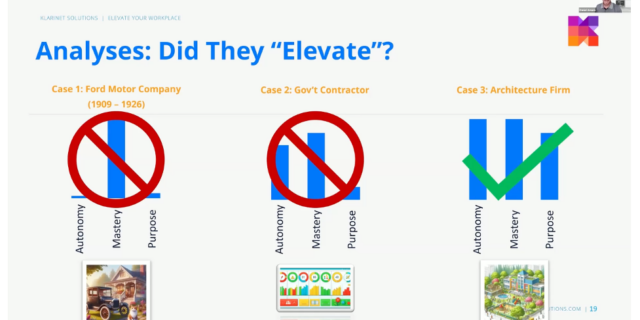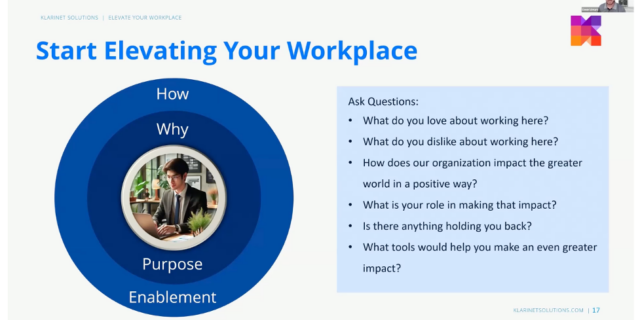Digital Workplace Technology to Help You Elevate
Creating a workplace where employees feel motivated and connected requires more than implementing the latest digital workplace technology. It’s about using that technology in ways that enhance people’s daily experiences, enable a sense of purpose, and align with a broader vision.
In our recent Elevate Your Workplace webinar, we explored what it means to truly elevate a workplace, how technology plays a role, and why autonomy, mastery, and purpose are essential elements in the process.
What Elevating the Digital Workplace Means
Elevating the workplace involves creating an environment where people feel a strong sense of purpose, connection, and growth. This goes beyond adding tools or improving productivity. While technology can streamline workflows and enhance collaboration, its real value shines when it supports a culture that prioritizes human needs.
A workplace focused on elevation prioritizes employee empowerment, using technology to free employees from repetitive tasks and enhance their focus on meaningful, impactful work. When employees feel encouraged to influence their work, grow their capabilities, and understand how their contributions fit into the larger vision, they’re more likely to thrive.
By aligning digital workplace technology with these goals, companies can create workplaces that are efficient and engaging, fostering an environment where every team member feels connected to their purpose and supported in their growth.
The Foundations of an Elevated Digital Workplace
Autonomy, mastery, and purpose in the workplace leads to higher engagement, stronger performance, and long-term retention. These three elements form the core of a culture that motivates employees to connect deeply with their work and contribute meaningfully.
Autonomy
Autonomy gives employees the freedom to make decisions and shape their work. This doesn’t imply a lack of structure but rather a supportive framework where team members are trusted to use their skills creatively. Allowing autonomy leads to greater accountability, ownership, and innovation, as employees feel empowered to make an impact within their roles.
Mastery
Mastery is the pursuit of skill growth and excellence. A workplace that values mastery provides ongoing learning opportunities—whether through challenging projects, mentorship, or skill-building initiatives. By encouraging development, organizations promote a growth mindset, enabling employees to achieve higher performance and adapt to new challenges.
Purpose
Purpose gives meaning to work, linking individual roles to the organization’s broader mission. When employees understand how their contributions matter, they’re more motivated and resilient. Purpose-driven work keeps employees engaged, as they feel connected to the impact of their efforts and the organization’s vision.

Digital Workplace Technology Driving Elevation
Let’s take a look at three organizations that used technology in different ways, with only one achieving a truly elevated workplace.
- Ford Motor Company (1909-1926): Ford transformed manufacturing with the assembly line, which made vehicles accessible to a wider audience. However, the repetitive nature of work left employees with little autonomy or purpose, leading to high turnover. Ford eventually raised wages to mitigate this, but the workplace environment remained largely task-focused.
- Government Contractor: This company introduced data-tracking dashboards and streamlined project processes. While the technology brought efficiency, it didn’t fully support employee autonomy or purpose, which limited its ability to create a truly engaging workplace.
- Architecture Firm: This fully remote firm has operated with virtual tools and flexible work arrangements for over a decade. Focusing on building schools, they connect employees’ roles with a meaningful purpose while promoting a flexible, empowering work environment. Through a combination of autonomy, mastery, and purpose, this firm created a supportive culture where employees feel engaged and aligned with the mission.
Steps to Start Elevating Your Workplace
To build a workplace where employees feel connected and supported, it’s essential to answer two key questions: Why (purpose) and How (enablement).
- Why (Purpose): Consider how the organization makes a positive impact and the unique role each employee plays in achieving that vision. When employees understand the significance of their work, they’re more engaged and motivated to contribute meaningfully.
- How (Enablement): Identify what tools, resources, or support employees need to excel. Technology should empower them to perform their best work and help them feel fully supported in reaching both personal and organizational goals.

By focusing on these questions, organizations can ensure their approach to technology aligns with purpose, enhancing both engagement and connection across the team.
Elevate Your Workplace by Prioritizing People and Purpose
Building an elevated workplace is an ongoing journey that involves creating an environment where employees feel valued, motivated, and aligned with meaningful goals. By focusing on autonomy, mastery, and purpose, companies can create a culture that fully supports employees, making technology an enabler of their best work.
When considering a new tool or system, ask yourself: Does this support our mission? Will it empower our employees to do their best work? With the right approach to technology and culture, you can create a workplace that elevates each person’s experience. We can help with this – just get in touch with our digital workplace experts.